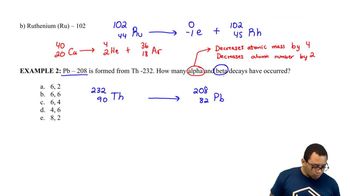Fluorine-18, which has a half-life of 110 min, is used in PET scans.
b. If 100. mg of fluorine-18 is shipped at 8:00 a.m., how many milligrams of the radioisotope are still active when the sample arrives at the radiology laboratory at 1:30 p.m.?
 Verified step by step guidance
Verified step by step guidance Verified video answer for a similar problem:
Verified video answer for a similar problem:



 2:09m
2:09mMaster Radioactive Half-Life Concept 1 with a bite sized video explanation from Jules
Start learning